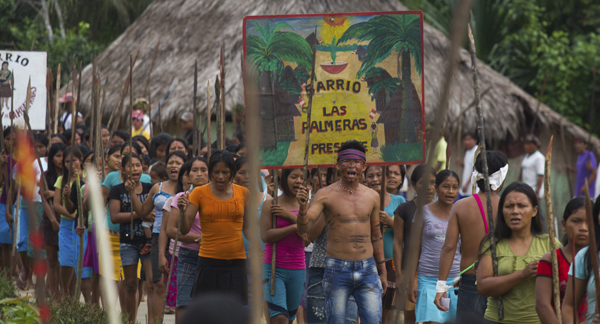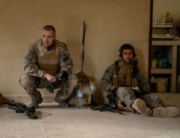
Peru’s indigenous Amazonian people protest in When Two Worlds Collide ((Jack Weisman/Yachaywasi Films)
At the start of this documentary, we see 2007 footage of Peru’s former president Alan García making his pitch to expand his country’s oil, mining, logging, and gas industries: “American entrepreneurs, bring your factories here. Come! You can trust that we’ll have long term stability.” Global capitalism, of course, has an odd way of defining “long-term stability,” conditions that ensure as much money as quickly as possible for a tiny group of major shareholders and executives of huge transnational corporations. Preserving one of the last great bastions of biodiversity left on the planet, the Peruvian Amazon, does not contribute to long-term stability as defined by most transnational corporations.
Filmmakers Heidi Brandenburg and Mathew Orzel embedded themselves with the Amazonian natives to chronicle the resistance to the corporate-friendly government of García for several years. Their central subject is Alberto Pizango, the president of the Interethnic Association for the Development of the Peruvian Rainforest, and the film charts his extraordinary efforts on behalf of his organization to halt both the forces eager to sell off the Amazon and the servile state that courts this destructive force.
Though the narrative covers several years and much political and legal maneuvering, it all unfolds clearly, comprehensibly, and, as tension builds, with a kind of unnerving inevitability. As the state undermines all diplomatic overtures by Pizango, violent conflict becomes increasingly inexorable. The native people, though comprising a staggering diverse range of ethnic and linguistic backgrounds, manage to form a cohesive, unified front of resistance. They make their stand in two key places—a stretch of jungle highway known as the Devil’s Curve and a major oil station, Petroperú station six.
In June, 2009, when the standoff was more than a month old, Police Special Forces began firing their assault rifles on native protesters armed only with spears. Eighty-two protesters suffered gunshot wounds, and nine succumbed to those wounds. The police did not escape unscathed, suffering 11 deaths among their ranks. The filmmakers were on the ground during this battle, filming bullets whizzing by, blood soaking the road, and the wounded being dragged off. This is cinematography on par with something out of Saving Private Ryan, but all the more impactful since it is nonfiction, not drama.
The film is especially timely, as two years ago WikiLeaks released State Department cables from 2009 revealing support for President Garcia’s crushing tactics. Indeed, these cables from Secretary of State Hillary Clinton’s State Department criticize García for not quashing more quickly and mercilessly the native resistance. They bemoan his softness and think it will unnecessarily slow down capitalization of resources in the Peruvian Amazon.
The film raises a number of difficult, important questions, notably about the nature of violence. Deforestation is one of the chief causes of climate change, since trees soak up carbon dioxide before it reaches the atmosphere. Is the destruction of the richest site of biodiversity in the world, especially at a time when climate change’s apocalyptic effects are becoming increasingly obvious, an act of violence? If that is too abstract, isn’t displacing nearly half a million native people a form of aggression? Or using assault rifles against people wielding spears? When the indigenous defended their land from transnational corporations by forming a human wall and their lives from gun-toting police by using spears, those were the only acts that the state and the media seemed able to classify as violent.
One of the most electrifying, informative, and relevant documentaries in recent memory, When Two Worlds Collide is required viewing.
















Leave A Comment